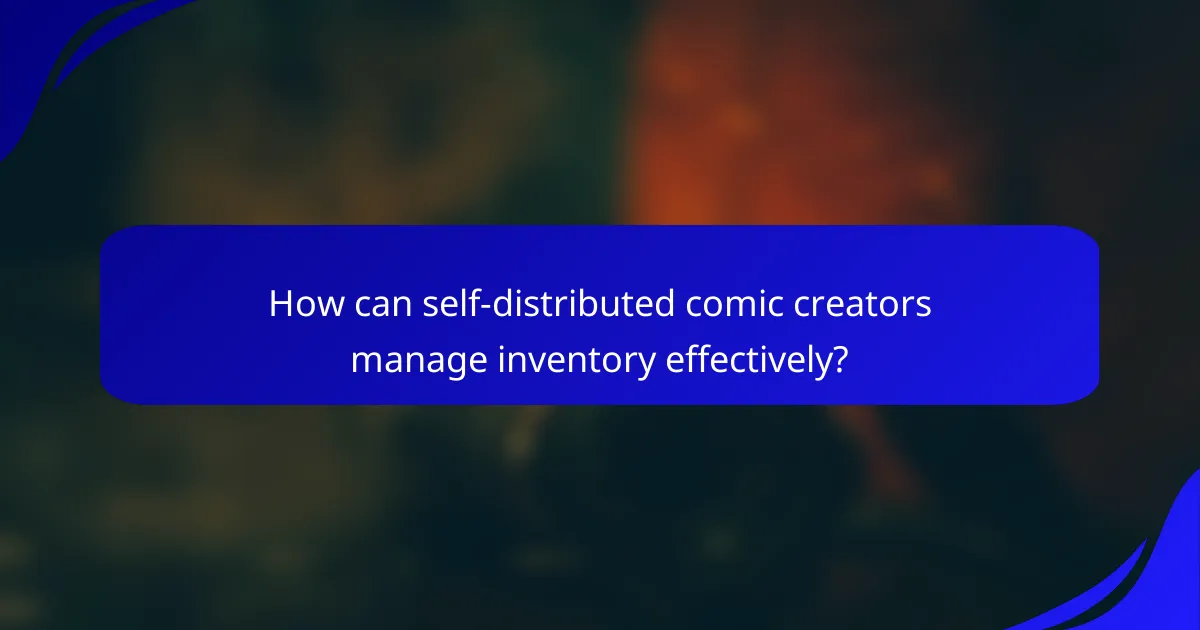Self-distributed comic creators face a range of logistical challenges that can impede their success, including limited distribution networks and high shipping costs. To navigate these hurdles, effective inventory management practices and strategic marketing efforts are essential. By utilizing tools like inventory management software and engaging with audiences through social media and conventions, creators can enhance their visibility and streamline operations.

What logistical challenges do self-distributed comic creators face?
Self-distributed comic creators encounter several logistical challenges that can hinder their success. Key issues include limited distribution networks, high shipping costs, inventory management difficulties, supply chain disruptions, and constraints on time management.
Distribution network limitations
Self-distributed comic creators often struggle with limited access to established distribution networks. Unlike traditional publishers, they may lack relationships with retailers and distributors, making it harder to get their comics into stores. Building a network through local comic shops and conventions can help, but it requires significant effort and time.
Shipping and handling costs
Shipping and handling costs can significantly impact a creator’s profit margins. Depending on the size and weight of the comics, shipping fees can vary widely, often ranging from a few dollars to over ten dollars per package. Creators should consider bulk shipping options or local delivery methods to minimize expenses.
Inventory storage issues
Managing inventory can be a logistical nightmare for self-distributed creators. Limited storage space can lead to difficulties in keeping track of stock levels and fulfilling orders promptly. Creators should evaluate their storage options, considering whether to use home storage, rented space, or print-on-demand services to reduce overhead.
Supply chain disruptions
Supply chain disruptions can affect the availability of materials needed for comic production, such as paper and printing services. Events like natural disasters or global shipping delays can lead to increased lead times and costs. Staying informed about suppliers and having backup options can help mitigate these risks.
Time management constraints
Time management is a critical challenge for self-distributed comic creators who often juggle multiple roles, from writing to marketing. Balancing creative work with logistical tasks can lead to burnout. Setting clear priorities and using tools like project management software can help streamline efforts and maintain productivity.

How can self-distributed comic creators manage inventory effectively?
Self-distributed comic creators can manage inventory effectively by implementing strategic practices that streamline stock levels, reduce waste, and align production with demand. Key methods include using inventory management software, adopting just-in-time inventory systems, tracking sales data for accurate forecasting, and utilizing print-on-demand services.
Using inventory management software
Inventory management software helps comic creators track stock levels, sales trends, and reorder points efficiently. These tools can automate alerts for low stock and provide insights into which titles are selling well, allowing creators to make informed decisions about restocking. Popular options include platforms like QuickBooks, Zoho Inventory, and TradeGecko.
When selecting software, consider features such as integration with e-commerce platforms, user-friendliness, and cost. Many solutions offer tiered pricing based on the number of users or inventory size, making it essential to choose one that fits your specific needs.
Implementing just-in-time inventory
Just-in-time (JIT) inventory management minimizes stock levels by ordering products only as needed. This approach reduces storage costs and waste, which is particularly beneficial for self-distributed comic creators with limited space. By coordinating closely with suppliers, creators can ensure timely deliveries that match their sales cycles.
However, JIT requires careful planning and reliable supplier relationships. Creators should maintain a buffer stock for unexpected demand spikes and have contingency plans in case of supply chain disruptions.
Tracking sales data for forecasting
Accurate sales data tracking is crucial for effective inventory forecasting. By analyzing past sales trends, comic creators can predict future demand and adjust their inventory accordingly. Tools like Google Analytics or sales reports from e-commerce platforms can provide valuable insights into customer preferences and seasonal trends.
Creators should regularly review their sales data to identify patterns, such as popular genres or peak purchasing times, allowing for proactive inventory adjustments. Establishing a routine for data analysis can significantly enhance forecasting accuracy.
Utilizing print-on-demand services
Print-on-demand (POD) services allow comic creators to print copies as orders come in, eliminating the need for large upfront inventory investments. This model is particularly advantageous for niche titles or limited runs, as it reduces financial risk and storage concerns. Popular POD platforms include Lulu, Blurb, and IngramSpark.
While POD offers flexibility, creators should consider production times and shipping costs, which can vary significantly between services. It’s essential to choose a POD provider that aligns with your quality standards and delivery expectations to maintain customer satisfaction.

What marketing strategies are effective for self-distributed comic creators?
Effective marketing strategies for self-distributed comic creators include leveraging social media, collaborating with influencers, participating in comic conventions, and utilizing email marketing campaigns. Each of these methods can significantly enhance visibility and engagement with potential readers.
Social media engagement
Social media platforms like Instagram, Twitter, and Facebook are essential for self-distributed comic creators to connect with their audience. Regularly posting updates, artwork, and behind-the-scenes content can build a loyal following. Engaging with followers through comments and direct messages fosters community and encourages word-of-mouth promotion.
Creators should consider using targeted hashtags and participating in relevant trends to increase visibility. Consistency in posting and maintaining a unique voice can help differentiate a creator’s work in a crowded market.
Collaborations with influencers
Partnering with influencers who have a strong following in the comic or graphic novel space can amplify a creator’s reach. These collaborations can take various forms, such as sponsored posts, reviews, or joint projects. Choosing influencers whose audience aligns with the creator’s target demographic is crucial for maximizing impact.
Creators should approach influencers with a clear proposal that outlines mutual benefits. Offering exclusive content or early access to new releases can incentivize influencers to promote the creator’s work effectively.
Participating in comic conventions
Comic conventions provide an excellent opportunity for self-distributed creators to showcase their work and connect directly with fans. Setting up a booth allows for face-to-face interactions, which can lead to immediate sales and valuable feedback. Networking with other creators and industry professionals can also open doors for future collaborations.
When attending conventions, creators should prepare promotional materials such as business cards, flyers, and merchandise. Engaging in panels or workshops can further enhance visibility and establish credibility within the comic community.
Email marketing campaigns
Email marketing remains a powerful tool for self-distributed comic creators to maintain contact with their audience. Building an email list through website sign-ups or social media can provide a direct line to fans for sharing updates, new releases, and exclusive content. Regular newsletters can keep readers engaged and informed.
Creators should focus on crafting compelling subject lines and content that resonates with their audience. Offering incentives, such as free digital comics or exclusive previews, can encourage sign-ups and increase engagement rates.

What tools can assist in logistics for comic creators?
Comic creators can enhance their logistics through various tools designed for shipping, inventory management, and customer relations. Utilizing the right software can streamline operations, reduce errors, and improve overall efficiency.
Shipping software solutions
Shipping software solutions help comic creators manage the logistics of sending their products to customers. These tools can automate label printing, track shipments, and provide real-time updates to both creators and buyers. Popular options include ShipStation and Pirate Ship, which integrate with various e-commerce platforms.
When selecting shipping software, consider factors like pricing, ease of use, and integration capabilities. Many services offer tiered pricing based on shipment volume, so assess your shipping needs to choose the best fit.
Inventory tracking applications
Inventory tracking applications allow comic creators to monitor stock levels, manage orders, and forecast future needs. Tools like TradeGecko and Square Inventory can help maintain accurate counts, reducing the risk of overselling or running out of popular titles.
Look for applications that offer real-time updates and reporting features. This can help you make informed decisions about restocking and identify which comics are performing well in the market.
Customer relationship management (CRM) tools
CRM tools are essential for comic creators to manage interactions with customers and build lasting relationships. Software like HubSpot or Zoho CRM can help track customer purchases, preferences, and feedback, enabling personalized marketing efforts.
Choose a CRM that integrates well with your existing systems and offers automation features for email marketing and customer follow-ups. This can save time and enhance engagement with your audience, ultimately driving sales and loyalty.

What are the key criteria for selecting distribution partners?
When selecting distribution partners, key criteria include cost-effectiveness, delivery speed, and geographic reach. These factors significantly influence the success of self-distributed comic creators in reaching their target audience efficiently and profitably.
Cost-effectiveness
Cost-effectiveness is crucial for comic creators, as it directly impacts profit margins. Consider the total expenses involved, including shipping fees, packaging costs, and any commissions taken by the distributor. Aim for partners that offer competitive rates while maintaining quality service.
To evaluate cost-effectiveness, compare multiple distributors based on their pricing structures. Look for options that provide bulk shipping discounts or flat-rate services, which can help reduce overall costs significantly. Always factor in hidden fees that may arise during the distribution process.
Delivery speed
Delivery speed is essential for maintaining customer satisfaction and managing inventory effectively. A faster delivery time can enhance customer experience and encourage repeat purchases. Assess potential partners based on their average delivery times and reliability in meeting those timelines.
Consider using distributors that offer expedited shipping options, especially for new releases or limited editions. Setting clear expectations with customers regarding delivery times can also help mitigate dissatisfaction if delays occur.
Geographic reach
Geographic reach determines how far your comics can be distributed, which is vital for expanding your audience. Choose partners that have a strong presence in your target markets, whether local, national, or international. This ensures that your comics can reach potential readers effectively.
Evaluate the distribution network of each partner, including their ability to ship to various regions and countries. For international shipping, consider customs regulations and potential delays, which can affect delivery times and costs. A partner with a broad geographic reach can open up new sales opportunities and enhance brand visibility.
